This Content Is Only For Paid Subscribers
Welcome to our new docuseries exploring what is happening to the office through the lens of trusted and emerging thinkers.
Larissa Conte says the pandemic has brought to light many tensions that previously went unnoticed, allowing organizations to consciously consider what is and is not working. By defining power as the capacity to move energy through systems, companies can evolve and create change across all levels.
Watch Next Video
Video Transcript
The Opportunity (01:02)
 One of the things that was so significant about the pandemic is that it created a global threshold. It was a deeply shocking event to all of humanity, and the way that a threshold event impacts us when a shock is delivered, it brings us into pause. And because it was such an extended pause and changing our routines, so many of the tensions that we were not all entirely collectively aware of, but maybe particular groups at work had been aware of tensions of how the office isn’t working or why this is hard, or why I feel uncomfortable here, why I feel like I don’t belong.
One of the things that was so significant about the pandemic is that it created a global threshold. It was a deeply shocking event to all of humanity, and the way that a threshold event impacts us when a shock is delivered, it brings us into pause. And because it was such an extended pause and changing our routines, so many of the tensions that we were not all entirely collectively aware of, but maybe particular groups at work had been aware of tensions of how the office isn’t working or why this is hard, or why I feel uncomfortable here, why I feel like I don’t belong.
Those came like roaring into relief. And as a ceremony designer and a rites of passage guide, what I know about thresholds is that when we come to these marking moments, we have the opportunity to consciously consider what has not been working that we wanna stop doing, that we want to shed, that we want to release. What is the essence of the office, of a gathering place that we must continue to honor?
And then what has never existed before, that we get the opportunity to dream into being. So in that way, the pandemic poses a fabulous opportunity in this reconsideration. You know, because for all of the hardship, we have the opportunity to pause and be more thoughtful, rather than continuing to waterfall forward decisions and ways of designing unconsciously.
One of the big questions that many people are sitting from, from designers to workplace
strategists, to all of the team members and leaders themselves, is what wasn’t working about the office before that we don’t wanna keep perpetuating. And what else do we need? What else do we want? Is the office even the solution to those needs and wants? So in the opportunity of taking this greater pause, we get to be more thoughtful about things.
Prior to the pandemic, there’s interesting context to know that there were all of these parallel movements happening in tandem. Contributing to reconsideration of the future of work and organizational evolution. So not just how we’re working with each other as teams, what that means in our spaces, what that means in how we make decisions and our governments from culture centered workplaces and considering what does it mean to put humanity in our people first? And how does diversity, equity, and inclusion play into this? How are we creating environments conducive to our greatest creativity and innovation? How are we using smart tech and data-driven information to guide our decision making as employees, not just with our product design? All of those were occurring in parallel prior to this moment, and they’ve been coalescing and weaving this conversation about the organizational evolution itself. So as organizations have been in this curiosity of how we conceive of ourselves, that is in deep relationship with the question of where do we live as organizations, whether it’s at an office or in distributed places.
Who Are We? (04:58)
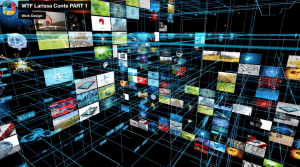 One thing that can be helpful in an organization asking ‘who are we?’ and ‘how do we conceive of ourselves differently?’, is recognizing the nested scales that the organization is a part of. In my work, I refer to this as the power landscape, that these are the five most relevant scales that are nested within the organization and that are larger than the organization and holding it, that all influence how we work.
One thing that can be helpful in an organization asking ‘who are we?’ and ‘how do we conceive of ourselves differently?’, is recognizing the nested scales that the organization is a part of. In my work, I refer to this as the power landscape, that these are the five most relevant scales that are nested within the organization and that are larger than the organization and holding it, that all influence how we work.
And those five scales are personal wellbeing, relationships and intimacy, the organization itself, organizational transformation, then society and ecology, and then out to what I call ceremony and meaning, which is the layer of our world views and how we make meaning with each other.
Part of this reconsideration of who we are as organizations is wiping away the illusion that the organization is not responsible for, nor connected to the other four scales of being. In fact, all of the advances happening in organizational evolution are creating connective tissue to the other five scales. It’s bringing back a wholeness and a systems thinking approach to the role of an organization in our larger societies and in our collective evolution as people.
So that’s one way that each individual organization can locate itself and consider who do we want to be in relationship to our individuals, the relationships we help grow here, the work we do together, how work participants in society and ecology, and then how we make meaning of purpose, because that’s a fundamental human question.
An organization is also an interesting scale of evolution because it evolves faster than societies, and it has more impact than just one-on-one relationships. So the amount of iteration and learning that can happen in our organizations is why there’s such an interesting scale for evolution and for us to pay attention to and invest in as our sites of learning, as we face all of these larger challenges in the climate, in society, and all throughout life.
The Concept Of Power (07:32)
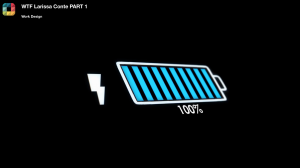 The unifying frame that I use to connect my understanding across all those levels is the concept of power. And I define power as the capacity to move energy through systems. So much like our organs live in our bodies. An organ organization lives within the scale of either it’s the nation in which it’s founded or within the whole human global society.
The unifying frame that I use to connect my understanding across all those levels is the concept of power. And I define power as the capacity to move energy through systems. So much like our organs live in our bodies. An organ organization lives within the scale of either it’s the nation in which it’s founded or within the whole human global society.
And to know that across scales of existence, there are always interactions. And power shows up in many different forms. So we have the opportunity as organizational leaders and as designers to start illuminating and getting more literate about our relationship with power. In essence, we have the opportunity to clean up our relationship with power because it’s often conceived of as something as dirty or bad or equal to power.
But instead, if we recognize, oh, we want to be able to move energy through systems, much like a watershed, you know, waterways that have clear flow, how can we bring that into the office, that into our teaming, that into our working? Because if we create clearer and higher volume flow, that benefits the whole. How amazing isn’t that part of the point of our collaboration?
The Office (09:05)
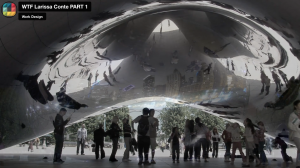 Right now, one of the biggest levers for the organization that the office poses is as a mirror of reconsidering ourselves. Because as we reconsider the role of the office, we’re also reflecting it back. Who have we been? How have we been? And maybe how have we been that we don’t wanna keep being? And how haven’t we been that we wanna start being?
Right now, one of the biggest levers for the organization that the office poses is as a mirror of reconsidering ourselves. Because as we reconsider the role of the office, we’re also reflecting it back. Who have we been? How have we been? And maybe how have we been that we don’t wanna keep being? And how haven’t we been that we wanna start being?
So there’s a beautiful quote by Rūmī, Sufi poet, who said anyone who steps inside the orchard, walks inside the orchard keeper. Which means that everything we create as designers, as planners, as experienced designers, as product designers, are all reflections of our beliefs about reality. So if we have problems or difficulties or tensions with what’s happening in our offices and ways that we’re feeling unsatisfied, those dissatisfactions and tensions are reflection of beliefs that are outdated or no longer working.
So the office has now become a realm reflecting back to us, how do we get to clean up our
belief systems and our relationship with power. This requires reconsideration, certainly on the personal level at least. And it can also ripple out to considering – who are we as teams? Who are we as an organization as a whole?
But it doesn’t mean all of our organizations need to end. It just means we get to have a different perspective. So many of the challenges we’re experiencing today at work and in the workplace are expressions of a similar consciousness, a similar pattern operating at those five different scales that I mentioned.
In this diagram, you’ll see things like people coming from depletion or people acting from their ego, or in our relationships where we feel codependent and we’re just coming from victim and victor cycles, where we’re just ensnared with each other. Or at work when we come from prioritizing profit first and power over other people or at the ecological and societal level, systems of colonialism and oppression and extraction, and in our meaning making, holding ceremonies or convening meaning making settings to establish power over and belittle others.
All of those tentacles, all of those tendrils are expressions of what I call shadow power or disconnection consciousness. The belief, the illusion that we are separate from each other, that each of those five spears actually, that they’re not interrelated, that they don’t interact, where in reality there’s interconnected tissue between all of them, between each of us.
So at work, when we don’t regard each other’s humanity, when we don’t take into account what it takes to be a parent. Or a caretaker of the elderly or a BIPOC member of the team, or an LGBTQ member of the team, or a disabled member of the team, or we don’t take into account the affluent that’s coming out of our offices or the monoculture planting of trees we have around our offices.
It’s coming from the belief that we’re not connected to or responsible for our relationships with each other. By contrast, there’s this notion of power that serves the whole. Across these same five scales, the way that looks is individually, we’re in our aliveness, in our relationships. We’re in interdependence at work.
We’re putting people first and prioritizing our relationships so that we can work at our highest octave of capacity in society and nature. We’re healing old historical wounds, regenerating our ecosystems and our communities, and countries. And then we’re connecting to meaning making settings to empower, heal, and connect with each other.
So in this way, moving from disconnection consciousness to connection consciousness at work in how we design is taking responsibility that we as designers will stop perpetuating long held biases, long held illusions that we don’t care for all people, that we don’t care for all beings.
The topic of power can feel daunting, especially when you see all the interconnected scales. But I want to remind you that our sovereignty exists in our own capacity as individuals and creators. We have the most determination over what we each individually do. And so, if we think of the design industry as a whole, and by the way, this is true for many industries, that there can be a lot of ego in design.
There can be a lot of designing and trying to move a design forward or a concept forward because we are excited about it and if we as designers don’t know how to distinguish our shadow power from our power that serves the whole, how do we know when we are advocating something in a project to a client, because it truly serves the organization, their mission, the people, the community, they plan to be in.
Or because we have an attachment to it that is perhaps more self-serving than we’d like to admit. That’s a first really powerful skill set to develop in recognizing our own design practice. Do I know when I’m putting this forward in service or I’m putting it forward because it feeds something in me alone.
Connection Derives Beauty (15:24)
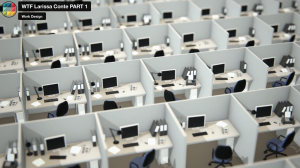 Being considerate of each other, being considerate of our own vitality, being considerate of what brings us peace and connection and creative capacity is not at the expense of beauty. It is an avenue to beauty. In fact, a lot of emphasis on productivity or efficiency or like squeezing the most out of something is where we can lose beauty.
Being considerate of each other, being considerate of our own vitality, being considerate of what brings us peace and connection and creative capacity is not at the expense of beauty. It is an avenue to beauty. In fact, a lot of emphasis on productivity or efficiency or like squeezing the most out of something is where we can lose beauty.
And so we don’t have to sacrifice efficiency. You know, we do wanna be productive, but also we want to be alive. We want to be flourishing, not just surviving and gritting through. So part of this also comes from how are we taking care of our own life force as designers? Because if we are working in a way, if we are pushing ourselves relentlessly, how can we possibly design an experience, a space and from a realm of consciousness that honors cycles and rest and renewal and people regenerating their own life force in their own places.
So it starts first with our own way of working and our own way of being as individuals to understand what we’re sourcing from, it can be very challenging to try to do that, otherwise.
Conducive To Life (16:49)
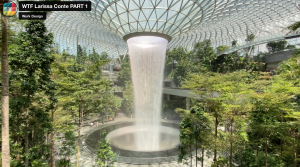 We can explore values by design, so designing from pattern to details, values for organizations who have a clear committed stand to serving the greater good for those organizations who already know. They’re invested in this transition to weaving more and more lived commitment to connection consciousness.
We can explore values by design, so designing from pattern to details, values for organizations who have a clear committed stand to serving the greater good for those organizations who already know. They’re invested in this transition to weaving more and more lived commitment to connection consciousness.
How does that show up in the space now? How does this show up in our design conversations now? How are we bringing in conditions conducive to life as founder of biomimicry, Janine Benyus says, and as all indigenous traditions from around the world have held. How are we considerate of breathing life back into our workplace?
Because, also this opportunity of the frame of regenerative design, not just sustaining because we have eroded our own life force, we’ve eroded our systems, you know, people are tired at this point. We need centers of recovery and healing and ways of working that revitalize us. So those are three big opportunities that I see right now if we want to take a seven generation’s view of design, especially since the built environment has so much permanence to it.
Feeling Inspired? Here Are the Actions You Can Take Now:
1) Engage intentional reflection on the office and yourselves
As an individual designer or even preferably as a team, reflect and surface answers to the following questions to deepen your design process about your office:
- What has not been working about the office that we want to shed, stop doing, or release?
- What is the essence of the office as a gathering place that we must continue to honor? (*focus on the functions, not the form of the office itself)
- What has never existed before that we get the opportunity to dream into being?
Along with those questions, I invite you to use your reflections on the office as a mirror for yourself and your teams.
- How have you been behaving individually and collectively that you want to stop energizing?
- How haven’t you been behaving individually and collectively that you want to bring to life?
2) Deepen understanding of your own gifts and shadows as a designer
Here are some prompts to help raise your self-awareness:
- Do you know how to recognize when you are designing something or advocating for an idea of yours for the benefit of the client and the whole vs when you’re coming from a solely self-serving place?
- What are the body indicators of when you’re in those two different states?
- What are the inner narratives you run in those two different states?
- How do you deal with critique in those two different states?
- When you notice yourself going into the mode of moving from mainly self-orientation, what’s 1 thing you can do to catch yourself and course correct into a bigger perspective?
Being able to recognize these patterns in ourselves is one of the most critical skills for designers and leaders of all types.
If you want to explore the 36 power types more fully, check out this free ebook, How to See Your Real Power, or get detailed information about how you express each of the power types via this Power Assessment for Leaders.
3) Design for your own vitality to be resourced in your life and work
We can only be as creative as we are personally resourced, grounded, and clear-minded. How are you feeling after the last few years? Do you feel as optimally resourced in how you care for yourself and how you’ve designed your own ways of working?
Here’s an article to help you understand the two main metrics to navigate by to expand your own aliveness, clarity, and creative power. If you want further support to evolve the next level of intentional designs for your ways of working to tend your own life force and sovereignty, check out this self-guided program and design immersion — Vital Leadership.
Resources:
Meet Larissa Conte:
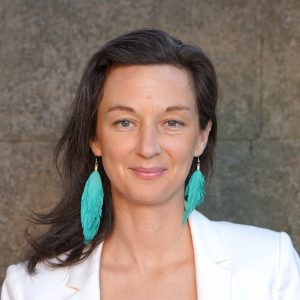 Larissa Conte founded Wayfinding in 2016 to equip leaders with enduring resources for embodying their sovereignty, following a life calling, and deepening their practice of Power that Serves the Whole.
Larissa Conte founded Wayfinding in 2016 to equip leaders with enduring resources for embodying their sovereignty, following a life calling, and deepening their practice of Power that Serves the Whole.
She is an internationally-recognized leadership coach whose insights on power source from 20+ years of devoted interdisciplinary study, application, and lived experience. With rich experience as a global consultant, coach, healer, regenerative designer, rites of passage guide, and tracker, she’s excited to offer this custom synthesis of insights and tools only found at Wayfinding to advance Power that Serves the Whole.
Larissa has served leaders from around the world in startups to the Fortune 100 with deep experience of over 20,000+ hours as a coach. She brings her knowledge to life through transformative methodologies, experiences, and initiations for leaders from all walks of service that invite their greater wholeness to emerge. She was formerly the Chief Culture and Design Officer at Invisible, a Senior Associate at Lippincott, and the Chief Happiness Officer at The Quality of Life Foundation. Larissa has a self-designed M.S. from Stanford University in Cultural Philosophy of the Environment and a life Ph.D. having spent 11.5 years healing from a near-fatal accident.
Episode 3 Part 1 Credits:
- Created By Bob Fox
- Produced By Work Design Magazine
- Directed By Bob Fox
- Edited By Katie Sargent & Bob Fox
- Special Thanks to Amanda Gram & Malena Boylan

